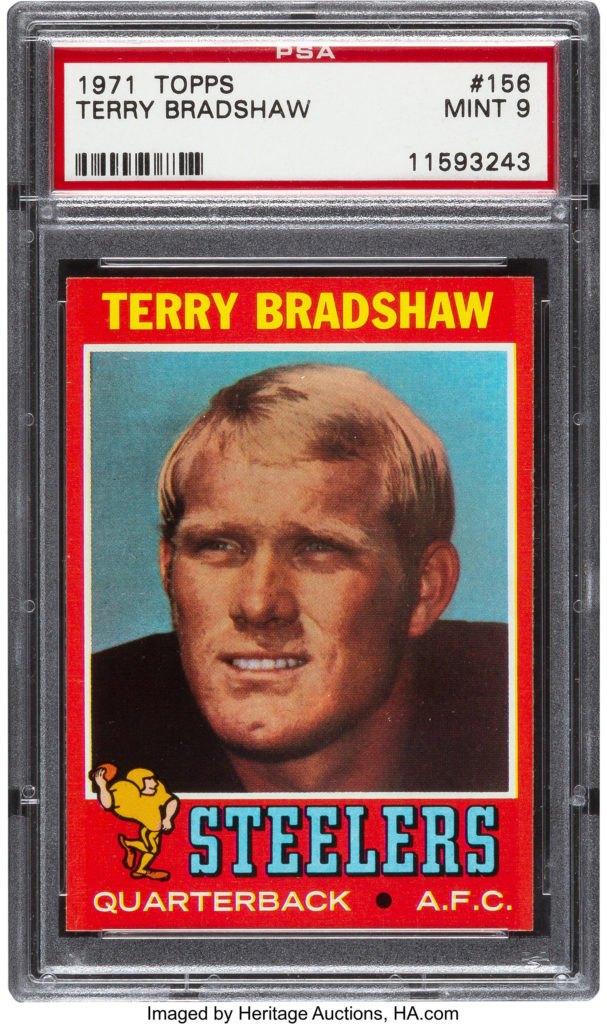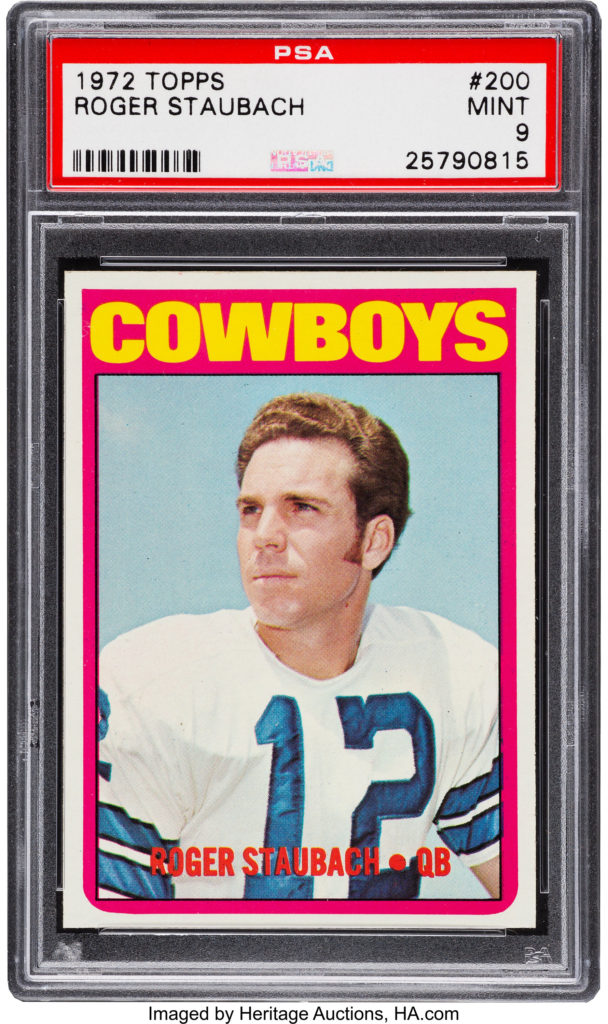September 2, 2021 marks the 73rd birthday for Hall of Fame quarterback Terry Bradshaw. His 14-year career as quarterback of the Pittsburgh Steelers was more than an impressive career. His statistics as a player might be lower than modern standards, but his results for the era easily make Bradshaw one of the NFL’s all-time quarterback greats. What about his rookie football and other top cards of the 1970s? There is a good case to make that Terry Bradshaw’s vintage football cards may be undervalued on a relative basis.
Bradshaw holds his own and then some among the football broadcasters and commentators to this day. That is impressive considering many players from his era are suffering from the effects of too many hard hits. And, again, he is 73 years old now. He has acted in multiple movies as well. Before getting into any absolute statements on values, the market is what determines fair value for any vintage cards and collectibles.
Collectors Dashboard evaluates high-end collectibles as an alternative asset class. This means that capital that would have otherwise been invested into stocks or bonds is used to buy collectibles. There is a case to be made as to why Terry Bradshaw’s rookie card and key 1970s cards may be undervalued on a relative basis, even considering rival Roger Staubach.
Terry Bradshaw’s 1971 Topps rookie sometimes seems underappreciated for the significance of his career on the field and after playing. We will take a look at player versus player, as well as rookie card and key cards from the 1970s to see how they are priced relative to each.
PLAYER vs. PLAYER
One key issue behind Terry Bradshaw’s entrance into the NFL is that he and rival Roger Staubach were coming up at the same time that quarterbacks of the late 1950s and early 1960s were starting to retire. This has Terry Bradshaw and Roger Staubach as the dominant team leaders of the 1970s.
First and foremost, Terry Bradshaw’s dominating career with the Steelers was hands down the best AFC team of his era. Bradshaw led the Steelers to 8 AFC Central titles. More importantly, his 4 Super Bowl championships is still tied with Joe Montana for second place (behind Tom Brady). And two of Bradshaw’s Super Bowl victories were over the Dallas Cowboys, with Staubach not defeating the Steelers in the Super Bowl.
Bradshaw’s 27,989 passing yards and 212 passing touchdowns were impressive statistics for the day. He was a tough as nails player when the game wasn’t only about long passes and having endless rules for protecting players on the offense. Defensive players were praised for knocking players out of a game (or just knocking them out). Bradshaw rushed for 2,257 yards in his career and also scored an additional 32 touchdowns on his own two feet.
Roger Staubach had the benefit of being quarterback for the more popular Dallas Cowboys, a.k.a. America’s Team. Staubach also came into the NFL later than normal (age 27) because of his service in the U.S. Navy, which also included a tour in Vietnam.
Staubach’s career was shorter than Bradshaw’s and he has only 2 Super Bowl victories versus 4 for Bradshaw. Staubach has 22,700 career passing yards and 153 touchdowns. He also ran for 2,264 yards and scored 20 touchdowns on his own two feet. His peak accomplishment at the time of his retirement was having the greatest career quarterback rating of all-time.
TOPPS’ ROUGH 1971 PRINTING YEAR
Evaluating prices on rookie cards can is sometimes like comparing Apples to Oranges. In the case of Bradshaw versus Staubach, the card prices are not significantly different for each player’s 1970s cards after each rookie card is eliminated from the mix. (Image provided by Heritage Auctions)

The year 1971 was a tough year for Topps when it comes to longevity of their cards’ ability to hold high grades. The black-border 1971 baseball set is perhaps the toughest vintage set for maintaining solid borders showing every ding and nick. Topps’ 1971 Topps football set was almost equally as difficult for maintaining higher grades.
The 1971 Topps football set had varying colors of blue and red from player to player. AFC players had red cards and NFC players had blue cards, while All-Pro players had blue tops and red bottoms. The solid bright red borders of Bradshaw’s rookie card make any blemishes from dings and chips stand out handily. The difference between a PSA 5 and a PSA 7 grade is generally speaking night and day in eye appeal as a result.
POPULATIONS
The PSA population report should outline how tough of a year 1971 was for maintaining conditions that would allow high grades. PSA’s population report for Bradshaw (card #156) has a total of 3,640 base grade examples. Of those, only 3 PSA perfect Gem Mint 10 grades exist. There are also only 20 examples at the PSA 9 grade. All in all, Terry Bradshaw’s card is not exactly scarce considering all grades, with other graded examples as follows:
- PSA 8.5 (22) and PSA 8 (447)
- PSA 7.5 (32) and PSA 7 (747)
- PSA 6.5 (34) and PSA 6 (871)
- PSA 5.5 (35) and PSA 5 (658)
There are many more graded cards in the 1972 Topps football set in general (versus 1971), but Staubach’s graded population of 3,216 base grade cards for #200 has just two PSA 10 and has 50 PSA 9 examples. The largest population is 746 examples graded at PSA 6. This sounds like a lower population than Bradshaw rookies, but this is clouded because of multiple “rookie” cards in the set. (Staubach image provided by Heritage Auctions)

What makes Staubach’s rookie year more clouded is that he has 818 graded cards of the #122 In-Action card. Of those, there are 5 at a PSA 10 and 104 at PSA 9. There is also a multi-player NFC Passing Leaders card (#4) with another 398 base grades at PSA – with 10 at PSA 10 and 64 at PSA 9. All of a sudden, there are nearly 4,500 cards from Staubach’s rookie year versus the 3,640 base grades for Bradshaw’s rookie year.
CARD PRICES FOR EACH
What stood out after looking at older price guides is the mix of valuations between Staubach and Bradshaw post-rookie cards of the 1970s. Some years favor Bradshaw and some favor Staubach cards for higher prices. Still, the 1972 Topps Staubach rookie over the same year Bradshaw card (2nd year) is many multiples of the price over Bradshaw.
PSA 8 examples of the Terry Bradshaw rookie sold for $1,500 in most of 2020, and more recent 2021 sales have gone off between $3,000 and $4,000 for that same PSA 8 grade. PSA has tracked only one PSA 9 sale in 2021 at $29,088 via PWCC in January, and that was when card prices were going bonkers. The last PSA 10 sale tracked by PSA itself was for $18,233.25 but that Memory Lane auction was back in 2006.
After looking at PSA data on PSA 8 graded sales of the #200 Staubach rookie, sales have seen some higher prices. His #200 card in a PSA was commanding $1,600 toward the end of 2020. The same PSA 8 grades have seen two sales above the $4,000 level in 2021 before dipping under $3,000 in June 2021.
Goldin Auctions sold a 1971 Topps #156 Terry Bradshaw Rookie Card graded PSA 9 for $12,000.00 in its October 2019 auction. Goldin’s highest Staubach rookie card sale in PSA 9 was $9,600.00, but that was in April of 2017.
A look at Heritage Auctions has shown multiple sales for PSA 9 cards. Heritage sold a PSA 9 Bradshaw rookie for $23,400 in December of 2020, but the same exact card (down to PSA identification serial number) fetched $50,190 in a May 2016 auction. Heritage sold a 1972 Topps Roger Staubach #200 PSA MINT 9 for $11,700 in December of 2020, but a same-grade example (not same identification serial number) sold for $14,340 in August 2016.
And in the end, neither Bradshaw nor Staubach are anywhere close to recent record football card prices. There is also a reminder that the “last price paid” can be irrelevant.
IN THE END…
Collectors Dashboard is always seeking more transparency in the collectibles business. This boils down to issues from grading to auctions to conventions and even to media coverage. After looking over the data, the rookie Terry Bradshaw from the 1971 Topps set has commanded higher absolute prices versus Roger Staubach’s rookie from the 1972 Topps set. Both are the anchor card for each year’s set, and both are in high demand by vintage football collectors.
A lot of this preference for collectors (and even collectibles investors) may boil down to preference and opinion. That may not seem out of the ordinary, but the Dallas Cowboys were a much more popular team outside of their own city than the Pittsburgh Steelers were. That said, the last Super Bowls either team has won was in 2009 and 2006 for the Steelers – and the Cowboys have to go back to the 1990s (’96, ’94, ’93) for their most recent Super Bowl wins.


